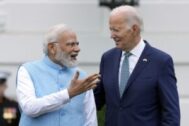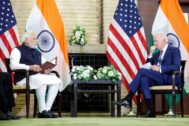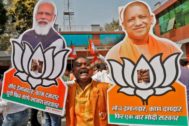Articles
US-India

US-India
January — April 2024Weathering the Crisis
This chapter was made possible through a grant from the Hindu American Foundation.
For the US-India bilateral relationship, the first four months of 2024 was a repeat of the quarters of the last three years. Differences in attitudes toward Cold-War era partnerships surfaced and upset the calm in bilateral relations. Still, there were significant strides in the economic and trade front. The dispute over the killing in Canada of a Khalistan separatist designated a terrorist by India marred the security partnership. Still, Washington continued diplomatically to support India vis-à-vis China’s provocations such as bestowing Chinese names on Indian towns. Visits by top American military brass underscored the growing security cooperation between the two democracies. The nature of electoral democracy, though, created some diplomatic tension. While heated rhetoric and polemical campaign statements in India provided fodder for the Western press to question the supposed “values-based” partnership with India, President Joe Biden’s suggestion that Japan and India were as xenophobic and anti-immigrant as Russia and China angered many in India.

This chapter was made possible through a grant from the Hindu American Foundation.
The Comparative Connections chapter on US-India relations covering the period September to December 2022 highlighted the challenge of getting past Cold-War era differences to fully capitalize on Indo-Pacific synergies. In the months between September and December of 2023, Cold War-era differences took center stage in the bilateral partnership. As a sliver of hope that the partnership would transform into a formal alliance emerged earlier in the year, these differences were spoilers. Differences in outlook brought to light the perennial challenges in the relationship and the need to get past the muscle memory of the Cold War for substantial engagement as defense and security allies. Despite these political and security differences, economic and technological cooperation largely expanded with increased cooperation in critical technologies and supply chain diversification initiatives. US industries broke new ground in expanding their footprint in India, and Indian conglomerates invested in the US, capitalizing on the Biden administration’s Inflation Reduction Act and other industrial policies.

US - India
May — August 2023From Non-Alignment to Realignment
This chapter was made possible through a grant from the Hindu American Foundation.
The US and India expanded cooperation across various domains in the second reporting period of 2023. The two moved to materialize projects and initiatives that were conceived in the first quarter, in wide-ranging domains with significant geopolitical and geoeconomic scope including defense cooperation, critical and emerging technologies, and infrastructure development. While New Delhi continued to straddle groupings such as BRICS, Shanghai Cooperation Organization, and the Quadrilateral Security Dialogue, the US-India partnership broke ground on more initiatives than any of India’s other bilateral relationships. Modi and Biden visited each other’s capitals and reaffirmed their commitment to a rules-based international order. The rousing reception Modi received in Washington and the continued US preeminence in most major trade and technology initiatives conceived by India highlighted the growing partnership between the two democracies. And the two leaders, while facing elections next year, seem willing to work together on common global priorities—sometimes at domestic political costs.

US - India
January — April 2023An Even Larger Role in Everything
This chapter was made possible through a grant from the Hindu American Foundation.
On May 24, 2022, President Joe Biden met Indian Prime Minister Narendra Modi on the sidelines of the Quad summit in Tokyo. According to the White House readout of the meeting, “The leaders reviewed the progress made in the US-India Comprehensive Global Strategic Partnership. They committed to deepen the Major Defense Partnership, encourage economic engagement that benefits both countries, and expand partnership on global health, pandemic preparedness, and critical and emerging technologies.” While such statements are often aspirational and lag in implementation, the first four months of 2023 show the renaissance in US-India ties to be real.

US - India
September — December 2022Friends with Benefits
This chapter was made possible through a grant from the Hindu American Foundation
2022 was a challenging year, not just for US-India relations, but for every India analyst trying to explain the Indian government’s position on the Russia-Ukraine conflict. Explaining to a non-IR audience India’s history of nonalignment during the Cold-War era and its current policy of multi-alignment was not a gratifying endeavor. While the last four months of 2022 did not have the friction and stress-tests as the first four of 2022 or the slow and steady expansion of relations that followed between May and September, they certainly had multiple surprising events that could make them the halcyon months of 2022. In mid-November, the US and Indian armies engaged in a military exercise at Auli, not far from the Line of Actual Control (LAC) separating Indian-held and Chinese-held territory. While the US and Indian armies have engaged in exercises prior to 2022, this proximity to the Indo-China border is a first. A month later, in another first, US Treasury Secretary Janet Yellen traveled to India to meet Indian Finance Minister Nirmala Sitharaman to expand the US-India “Indo-Pacific partnership.” Yellen characterized India as a “friendly shore” for supply chain diversification and as the indispensable partner for the US.

US - India
May — August 2022Relations at 75: Hawaii to the Himalayas
This chapter was made possible through a grant from the Hindu American Foundation
Like the saying, “after the storm comes the calm,” US-India relations witnessed four months of productive talks, cooperation, and collaboration. This contrasted with the previous trimester, mired as it was by Cold-War era differences brought about by the Russia-Ukraine conflict. There were thriving Indo-Pacific synergies and the decline of Cold War-era differences. The US and India continued and expanded cooperation on a wide array of regional and global issues, such as climate change, supply chains, and the Sri Lankan crisis. They solidified their defense partnership from Hawaii to the Himalayas through navy and military exercises. The US turned down pressure on India over Russian oil purchases and recalibrated the dialogue to address other pressing challenges. They did not avoid tough conversations, however. India reinforced its view of the US and other Western nations’ role in keeping the Indo-Pacific a safer and more open region.
While minor differences remain, the two democracies found common ground in addressing what they both consider to be the most pressing challenges: China’s belligerent actions and the existential threat of climate change. Their targeted actions to address the two issues became more overt and coordinated. Through the launch of initiatives such as the Indo-Pacific Economic Framework (IPEF), the Biden administration reentered the Asian economic architecture—though not through a trade agreement—bringing otherwise-hesitant economies, including India, into the fold.
Domestically, Biden and Modi were both preoccupied with amending historic injustices and preparing their societies and economies for 21st century challenges.

US - India
January — April 2022Cold-War Era Differences & Indo-Pacific Synergies
This chapter was made possible through a grant from the Hindu American Foundation.
2022 started with a surging omicron wave, followed by Russia’s invasion of Ukraine and a global food, energy, and supply shortage crisis that impacted a wide range of sectors. The United States and India worked collaboratively and individually to put out these fires over the first four months of 2022, becoming more aware of synergies to build on and differences to address. In the first four months of 2022 bilateral ties witnessed successes in their joint efforts. The Comprehensive Global Strategic Partnership between the US and India was in action through cooperation on vaccines and COVID-19-related supply chain resiliency initiatives. During the reporting period, India removed several agricultural trade barriers, the US unveiled its Indo-Pacific Strategy, foreign and defense ministers held their 2+2 meeting, and there were several phone conversations and in-person meetings between the two administrations discussing Ukraine, Afghanistan, and other Indo-Pacific issues. Historically, foreign affairs has not played a significant role in Indian state-level elections. However, domestic politics in India has a significant impact on foreign relations. On topics of trade, economic cooperation, infrastructure development, and even human rights, developments in state elections can profoundly impact US-India relations.
US-India
September — December 2013Seeking to Sustain the New Normal
The tenor of US-India relations in 2013 was similar to that articulated by then Secretary of State Hillary Clinton in 2012 when she spoke of the need for “daily, weekly, monthly collaboration” rather than dramatic breakthroughs. In a February 2013 visit to Washington, Foreign Secretary Ranjan Mathai echoed these comments. He argued that the bilateral relationship has reached a “new normal” in which consultation has become a habit. For its part, the Obama administration continued to hail the relationship as a defining partnership. There were about 60 official visits during the year and about 35 different dialogues, working and consultation mechanisms to move the relationship forward. The areas of discussion and action covered commercial ties including trade and investment, defense relations, a special focus on Afghanistan, and broad consultation on Asia-Pacific and global issues.
India - East Asia
January — December 2011Triangulate This
Over a decade into the “normalization” of US-India relations and nearly 20 years into India’s “Look East” policy, the US-India-East Asia nexus is regularly articulated by the US and India, generally accepted in the region, and shows some signs of gaining traction including a regular US-India dialogue on East Asia and the launch of the first-ever US-India-Japan trilateral dialogue. More broadly, US views of India as part of Asia now encompass mental as well as policy maps (though not yet bureaucratic and all geographical ones) and transcend party politics. Meanwhile, US-India bilateral relations move steadily if sometimes frustratingly forward, and India-East Asia ties continue to deepen and widen though to neither side’s full satisfaction. One thing is clear: triangulation depends above all on India’s own commitment and actions to build a closer relationship with the wider Asia-Pacific region. Secretary of State Hillary Clinton, in an echo of comments made by regional leaders over the years, told an Indian audience in Chennai in July that “India’s leadership will help to shape positively the future of the Asia Pacific. That’s why … we encourage India not just to look east, but to engage east and act east as well [emphasis added].”
India - East Asia
January — December 2010Better Atmospherics, Similar Substance
High-profile visits and meetings characterized Indian relations with both the United States and East Asia in 2010. While there were no major “breakthroughs” or departures as a result, the ongoing evolution of both US-India and India-East Asia relations suggests that they are now a fixed part of the US-Asia dynamic. It is worth noting that while Secretary of State Hillary Clinton neither visited India during her first trip to Asia in February 2009 (she did visit India in July 2009) nor made mention of India in her pre-departure address on US Asia policy, in November 2010 President Obama opened his speech to the joint session of India’s Parliament by declaring that “[i]t’s no coincidence that India is my first stop on a visit to Asia…” And the joint statement between the two countries issued during that visit specifically noted a “shared vision for peace, stability and prosperity in Asia, the Indian Ocean region and the Pacific region…[and] agreed “to deepen existing regular strategic consultations on developments in East Asia…” Indeed, including India at all in an Asia itinerary is a recent innovation in US foreign policy and one that speaks to a larger US policy debate about the evolving Asia-Pacific. Whether such an innovation sticks remains to be seen, although many indications suggest that it will; especially as the need to coordinate increases on matters such as the East Asian Summit, maritime cooperation across the “Indo-Pacific,” and wider global issues.
India - East Asia
October — December 2003Delhi’s Two-Front Diplomacy
The past two years have been especially full for India’s diplomacy – both toward the United States and East Asia. Toward the U.S., India, by mobilizing hundreds of thousands of troops along the international border with Pakistan following an attack on the Indian Parliament in December 2001, was engaged in “coercive diplomacy” aimed at getting Washington to pressure Pakistan to halt cross-border infiltration into Kashmir. For much of 2002 and half of 2003, U.S.-India relations were preoccupied with getting Pakistan to carry through on its commitments, preventing further escalation or miscalculation of the crisis, initiating a political process in Jammu and Kashmir, and nudging India-Pakistan relations toward dialogue. Simultaneously, the U.S. and India worked to implement the “big idea” of the Bush administration to transform U.S.-India relations through enhanced defense cooperation, improved trade, and wider political and security consultations. On both these counts, the U.S. and India achieved some progress – though not smoothly.
India in 2003 was also pursuing an improvement in relations with its rapidly growing neighbor, China, while building on the past few years of steady improvement with Southeast Asia, and to a lesser extent Japan. While no dramatic events or breakthroughs have occurred, an incremental but steady focus by India on East Asia has been maintained despite severe India-Pakistan tension during all of 2002 and the first half of 2003.
This article, building on earlier reviews of U.S.-India (see “U.S.-India Relations: Visible to the Naked Eye,” Comparative Connections, Vol. 3, No. 4) and India-East Asia Relations (see “India-East Asia Relations: The Weakest Link, but not Goodbye,” Comparative Connections, Vol. 3, No.1, January 2003), examines U.S.-India and India-East Asia relations in 2002-2003 and 2003 respectively.